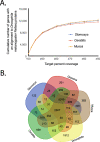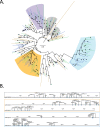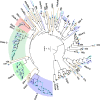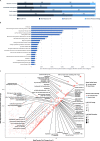The genome of the stable fly, Stomoxys calcitrans, reveals potential mechanisms underlying reproduction, host interactions, and novel targets for pest control
- PMID: 33750380
- PMCID: PMC7944917
- DOI: 10.1186/s12915-021-00975-9
The genome of the stable fly, Stomoxys calcitrans, reveals potential mechanisms underlying reproduction, host interactions, and novel targets for pest control
Erratum in
-
Publisher Correction: The genome of the stable fly, Stomoxys calcitrans, reveals potential mechanisms underlying reproduction, host interactions, and novel targets for pest control.BMC Biol. 2021 Jul 29;19(1):150. doi: 10.1186/s12915-021-01098-x. BMC Biol. 2021. PMID: 34325695 Free PMC article. No abstract available.
Abstract
Background: The stable fly, Stomoxys calcitrans, is a major blood-feeding pest of livestock that has near worldwide distribution, causing an annual cost of over $2 billion for control and product loss in the USA alone. Control of these flies has been limited to increased sanitary management practices and insecticide application for suppressing larval stages. Few genetic and molecular resources are available to help in developing novel methods for controlling stable flies.
Results: This study examines stable fly biology by utilizing a combination of high-quality genome sequencing and RNA-Seq analyses targeting multiple developmental stages and tissues. In conjunction, 1600 genes were manually curated to characterize genetic features related to stable fly reproduction, vector host interactions, host-microbe dynamics, and putative targets for control. Most notable was characterization of genes associated with reproduction and identification of expanded gene families with functional associations to vision, chemosensation, immunity, and metabolic detoxification pathways.
Conclusions: The combined sequencing, assembly, and curation of the male stable fly genome followed by RNA-Seq and downstream analyses provide insights necessary to understand the biology of this important pest. These resources and new data will provide the groundwork for expanding the tools available to control stable fly infestations. The close relationship of Stomoxys to other blood-feeding (horn flies and Glossina) and non-blood-feeding flies (house flies, medflies, Drosophila) will facilitate understanding of the evolutionary processes associated with development of blood feeding among the Cyclorrhapha.
Keywords: Chemoreceptor genes; Gene regulation; Insect adaptation; Insect immunity; Insect orthology; Metabolic detoxification genes; Muscid genomics; Opsin gene duplication; Stable fly genome.
Conflict of interest statement
The authors declare that they have no competing interests.
Figures










References
-
- Dougherty CT, Knapp FW, Burrus PB, Willis DC, Burg JG, Cornelius PL, Bradley NW. Stable flies (Stomoxys calcitrans L) and the behavior of grazing beef cattle. Appl Anim Behav Sci. 1993;35:215–233. doi: 10.1016/0168-1591(93)90138-F. - DOI
-
- Dougherty CT, Knapp FW, Burrus PB, Willis DC, Cornelius PL. Moderation of grazing behavior of beef cattle by stable flies (Stomoxys calcitrans L) Appl Anim Behav Sci. 1994;40:113–127. doi: 10.1016/0168-1591(94)90076-0. - DOI
-
- Dougherty CT, Knapp FW, Burrus PB, Willis DC, Cornelius PL. Behavior of grazing cattle exposed to small populations of stable flies (Stomoxys calcitrans L) Appl Anim Behav Sci. 1995;42:231–248. doi: 10.1016/0168-1591(94)00546-Q. - DOI
Publication types
MeSH terms
Grants and funding
LinkOut - more resources
Full Text Sources
Other Literature Sources
Molecular Biology Databases

